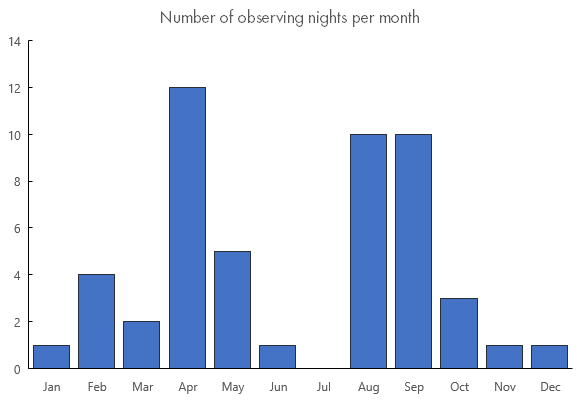 |
| click to enlarge |
First of all, a Happy, Healthy and Clear 2024 to all the readers of this blog!
The past year has been an active and productive year. I did optical observations on 50 nights, gathering 14069 astrometric positions on 108 objects, of which 73 were classified objects.
2081 of these astrometric positions were obtained (on both classified and unclassified objects) as part of my regular observational activities.
In addition to these, 6794 astrometric positions were obtained on the SWARM A, B and C satellites, as part of camera and timing accuracy calibrations (see this earlier post). And 5194 astrometric and photometric datapoints were gathered on BlueWalker 3, which - together with data from 2022 - are part of this study published in Nature.
The image in top of this post, shows all 14069 datapoints gathered in 2023 plotted on a star map. Red crosses are from my regular observing activities; blue crosses are data on BlueWalker 3; and green crosses are data on the SWARM satellites. The diagram below shows the distribution of observing nights over the year:
The past year had several personal and observational highlights. These include:
1. My Lecturer position at the Delft Technical University Faculty of Aerospace Engineering became a permanent position
2. I was co-author to this study published in Nature, on the high brightness of BlueWalker 3
3. Observing the RNLAF cubesats BRIK-II, HUYGENS and BIRELAND (see this post)
4. Being filmed for a very nice 40-minute documentary by the Dutch TV program FOCUS about 'War in Space', for which we filmed at the RNLAF headquarters and my home.
5. Being filmed, as one of three specialists, for this very nice short informative video by the 'University of the Netherlands' on 'War in Space', part of an informative web-series called 'Voorkennis' ('foreknowledge'):
6. Recovering several high altitude objects not seen for a while by our network, including USA 310, PAN and several other GEO and HEO objects.
7. Forecasting the reentries of the North Korean satellites Kwangmyŏngsŏng (KMS) 3-2 and 4
8. Forecasting the reentry of the TU Delft cubesat Delfi-C3.
 |
| screenshot from the NTR FOCUS tv documentary (me at left, Major Wijnja at right) |
Apart from the already mentioned Nature paper, I also published this Conference Contribution on the work of our network of Independent Satellite Observers, the result of partin g in the 2nds NEO and Debris Conference in Darmstadt in January.
I have been in the media several times on topics including Starlink and the war in Ukraine, Starlink and the quick rise of the number of objects in orbit, space debris in general, the reentry of two North Korean satellites, and the Launcher One mishap, as well as a number of missile tests.
During the second part of the year, I had the opportunity to gather data on MEO, HEO and GEO objects while testing a prototype tracking camera that in 2024 will be placed on the roof of the TU Delft Faculty of Aerospace Engineering. The imagesbelow were obtained with this camera.
 |
| 6U cubesat Huygens imaged on 7 Sept 2023. Click to enlarge |
 |
| following the movements of PAN/NEMESIS-1. Click image to enlarge |
 |
| Russian SIGINT satellite LUCH (OLYMP) 2. Click image to enlarge |

No comments:
Post a Comment